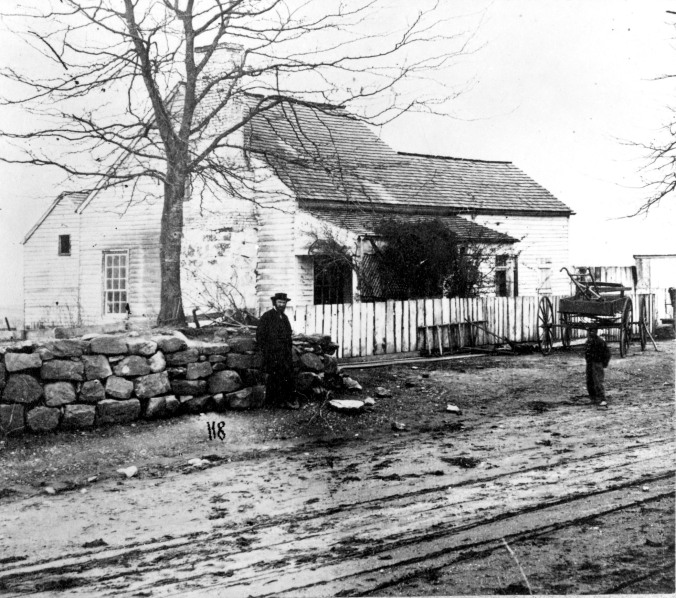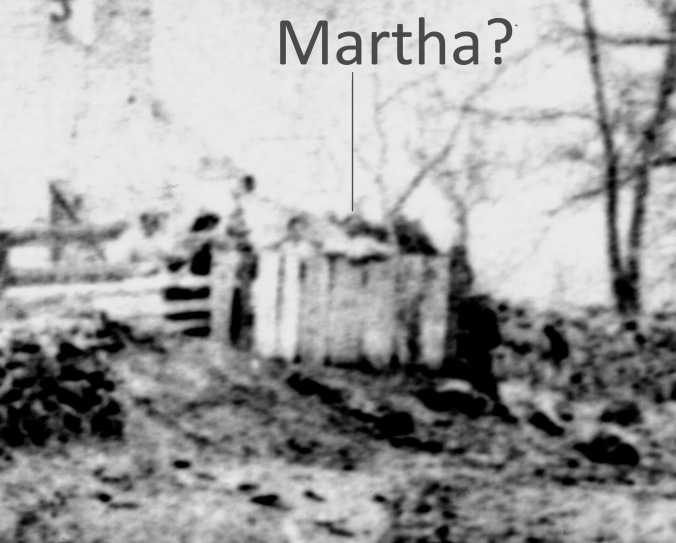From John Hennessy (For part 2 of this post, click here. For a prior post on the possibility of Martha Stevens appearing in a postwar image, click here):

The UDC monument to Martha Stephens, at her house site on Sunken Road.
Just down the Sunken Road from the magnificent memorial to Confederate soldier Richard Kirkland, the “Angel of Marye’s Heights,” is a far simpler monument, put in place in 1917 by the United Daughters of the Confederacy to mark the home of one of Fredericksburg’s most honored and memorable women. “HERE LIVED MARTHA STEVENS FRIEND OF THE CONFEDERATE SOLDIER 1861-1865.”
In 1860, few in Fredericksburg would ever have predicted that Martha Stevens (or Stephens–the spellings seemed to have been interchangeable) would, 57 years hence, be the ONLY woman of the town to be honored with a monument to her acts during the Civil War. Indeed, to most Fredericksburgers, she would have been near the bottom of the list of prospective heroines, for Martha Stevens lived an unconventional life on the edges of Fredericksburg society.
Born, apparently, as Martha Farrow, by 1860 the 36-year-old was on her third surname, though there is no record that she ever stepped before minister or Justice of the Peace to be married. Her son was named John Innis (or Ennis), and she occasionally went by that surname. In the several court cases in which she was involved, she is variously identified as Farrow, Innis, or Stevens (or Stephens). By 1860 she was living along the Sunken Road with cabinetmaker Edward N. Stevens, along with two young girls, Mary (10) and Agnes (5) named Stevens.
This meander through the morass of names is not intended to confuse, but to highlight that Martha lived a life far different than those other Fredericksburg women who have come to us as part of the town’s Civil War history–Betty Maury, Jane Beale, Lizzie Alsop, and others. But her ever-changing identity is only part of her distinctiveness. There is no record that Martha ever married Edward Stevens–rather, their marriage was common-law. They lived together for probably 29 years, until his death in 1883. He was a cabinet-maker, and perhaps not a good one, since he was, at least in the 1850s, in serious debt. Virginia law at the time required that the property of women entering into marriage automatically pass to the man–in this case any such property would have been used to satisfy Stevens’s debts. It is likely for this reason that Martha never married Edward. Indeed, in 1854, she entered into a trust with Peter Goolrick that secured her rights to her property entirely separate from Edward or any other man. Indeed, in all known legal documents relating to Martha, she used either Innis or Farrow as her name, with Stevens given only as an alias.

Martha Stevens's house along the Sunken Road--a postwar image.
Martha Stephens, despite her discolored reputation, was if nothing else an effective wheeler-dealer. Her worth was considerable: two house on the Sunken Road (including today’s Innis house), a couple of lots on George Street and, most importantly, a 92-acre farm she acquired in 1869–all in her own name.
Her independent ways in the legal and real estate realms surely marked her as different, but so did her personality and other entrepreneurial ventures. Even one of her greatest post-war admirers, John T. Goolrick, called her “uneducated, too free and too outspoken in what she said and how she said it.” She was illiterate, irrreligious and smoked a pipe, and by at least two accounts she may have associated with African-American men. Some whispered that she had been a prostitute, though there is no evidence today to support that claim. In 1854 and again in 1863, she was charged with running an illegal saloon in her home. Her unquestioned status as a saloon-keeper certainly did much to cement her local reputation as what one man later described, “a woman of abandoned character and an outcast of society.”

Does this blowup from an 1866 photograph of the Sunken Road and Innis house show Martha Stevens?
This unconventional woman seems an unlikely candidate for the only memorial to a Civil War-era woman in Fredericksburg. But, on December 13, 1862, her house sat in the middle of the battlefield at Fredericksburg, along the Sunken Road, filled with Confederate soldiers, Confederate generals, and by some accounts, Confederate wounded. Dozens of accounts at the time and later referenced her home, which by at least two estimates suffered more than 1,000 bullet holds. But what of the woman of that house? What do we know about her activities that day? More importantly, how did she go from pariah to heroine? And is her Richard Kirkland-like emergence as a Southern hero after the war a function of fact or mythology?
We’ll look at all that in our next…..



Martha Stevens’ habit of puffing on a pipe does not contribute to her uniqueness. It was certainly commmon for women to smoke pipes long before Martha’s time and long after.
Thanks for the commentary on Martha Stephens. While at the sunken road yesterday, I noticed the different spellings of her last name between the marker shown above and a nearby plaque identifying the remains of the foundation of her home nearby. My last name being Stevens as well, I have seen this same interchangeability in my own family when ‘chasing ancestors’. While my name was passed to me by my father, his father’s name on the birth cert. was Stephens, and he passed before I knew this or could ask why. Our family from the Sandy Bottom region of W.VA near to where the Hatfields and McCoys feuded have no known relation to Martha – but imagine walking the sunken road and encountering the stone – for just a few minutes I wondered.